Seville Cathedral: Main Sacristy
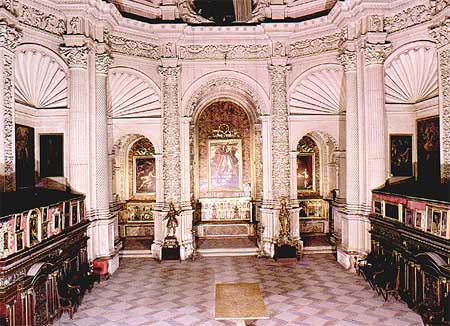 Main Sacristy
Main Sacristy
|
Above the iron screen of the chapel leading to the Main Sacristy there is a beam with mineteen paintings, The one in the centre being a Pietà, with prophets and apostles in the others on either side.
They are of excellent quality and were probably painted in the first quarter of the 17C. In the upper wall there is a stained-glass window by Arnao de Flandes dating from 1556. It depicts The Cleansing of the Temple.
The chapel leading to the Sacristy has two large wooden cupboards where different liturgical objects are kept. They were built by Pedro Duque Cornejo in 1743.
The reliefs in the right-han cupboard show The Harvest of Manna an Moses makes Water come out of the Rock, and that on the left-hand side shows Adam and Eve in Paradise and Twenty Saints and Martyrs.
In the front wall of this chapel there is the Portal of the Sacristy, richly decorated in the Plateresque style.
The soffit of the bevelled entrance arch has a series of carved caissons with fruit and other food. The wooden doors designed by Diego Guillen Ferrant were built between 1547 and 1549 and are of great quality.
They include reliefs of San Isidoro and San Leandro as well as of Las Santas Justa y Rufina.
|
The inside of the Main Sacristy is a solemn area with a ground plan in the form of a Greek cross with very short arms. It is roofed with a dome resting on pendentives.
The vertical section consists of pillars to which half columns and pilasters are attached, the profile of which is richly decorated in the Plateresque style. Above the capitals there is an elegant decoration of grotesques and garlands.
The arms of the cross are roofed with fan vaults rest on chamfers decorated with scallops.
The dome is decorated with three rings of reliefs representing The Final Judgement with the figures of Chris between the Virgin and John the Baptist as well as a scene of the Heavenly Host with Prophets, Patriarchs, Saints and Angels; the bottom ring shows the Damned. The images in the vaults represent apostles and bishops.
There are also four tondi with the figures of the evangelists. The back of the door is decorated with the heads of prophets, virtues and cherubim
Before one enters the Sacristy, one should stop and comtemplate the painting on the wall to the left of the door. It depicts St Antony with the Child and may be ascribed to the workshop of Zurbarán.
|
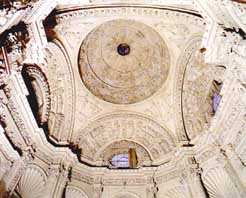 The vault of the Main Sacristy
The vault of the Main Sacristy
|
There is documentary proof that initially the Main Sacristy was built following a project of the architect Diego de Riaño. When hr died in 1534, Martín de Gainza continued his work until 1543 when the area was finished.
|
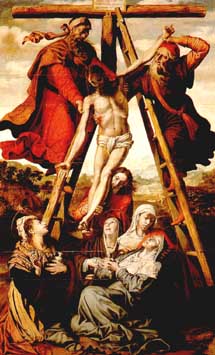 The Descent by Pedro de Campaña
The Descent by Pedro de Campaña
|
The supports of the three altars which used to stand in each of the chapels and were dismantled in the 19C are still to be found at the wall at the head of the Sacristy.
These supports have small sculptures and some shrines. At the front of the central chapel there is a large work of art by Pedro de Camapaña, signed and dated 1547.
It shows the Descent from the Cross and is a painting from the vanished Santa Cruz Parish Church, from where it came to the Cathedral in 1814.
|
The composition of this painting follws a strict geometrical order inspired by a print by Marco Antonio Raimondi. The severe composition, however, is overcome by the intense drama surrounding the group of figures playing the main role in this trascendental moment.
In the side chapels there are a painting of St Teresa by Zurbarán on the right and The Martyrdom of St Lawrence, probably by Lucas Jordán, on the left.
|
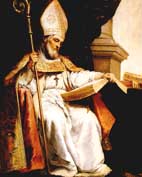 San Isidoro by Murillo.
San Isidoro by Murillo.
|
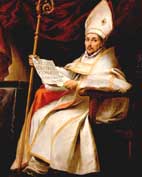 San Leandro by Murillo
San Leandro by Murillo
|
On the walls of the Main Chapel there is a large collection of paintings which are described below beginning at the entrance door and from right to left.
First comes an Angel with the symbols of the passion, which is an anonymous painting from the end of the 17C.
Then there is a painting of Christ appearing to St Ignatius of Loyola, Probably by Alonso Vázquez from around 1600
The centre of the left wall shows San isidoro by Murillo. It was painted in 1655 and its most outstanding feature is the solemn figure of the Saint bent in thought over one of his literary works.
|
The Saint´s face is traditionally help to be the portrait of the bachiller Juan López Tabalán.
After that there is an anonymous Inmaculada from around 1630 and then an Angel from the end of the 17C.
On the pilaster flanking the front we find a St Jerome, which is a copy by Ribera. On the opposite pilaster there is a St Sebastian signed by Ramon Bayeu, followed by another 17C Angel and then by La Virgen de la Merced, a painting by Juan de Roelas from around 1624.
In the centre of the right-hand wall there is San Leandro by Murillo from 1655. His face is said to be that of the bachiller Alonso de Herrera, a prompter of the Cathedral choir.
|
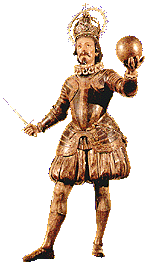 San Fernando. A sculpture by Roldán.
San Fernando. A sculpture by Roldán.
|
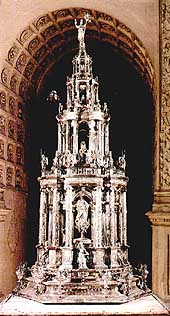 A mostrance by Arfe
A mostrance by Arfe
|
The Saint is looking at the visitor showing him a sheet with a sentence in Latin referring to his fight against Arian heresy.
After that there are a Vision of St Francis signed by Juan Sánchez Cotán in 1620 and another Angel as part of the series described earlier.
On this side wall, which forms an angle with the back wall, we find The Virgin with Child, a copy by Ribera, in the top part, and a Crucified Christ below, signed by Sebastian de Llanos in 1666.
Along the back wall there are The Building of Solomon´s House, an anonymous painting from the 18C, and The Beheading of St John the Baptist by the Genoese painter Valerio Castelo from around 1650, The Martyrdom of San Hermenegildo, by a 17C anonymous artist, and St John the Baptist by Francisco Polanco from around 1650.
Several sculptures are displayed in this Sacristy, the most inportant being that of San Fernando on a silver pedestal next to one of the pillars at the front.
It is by Pedro Roldán who made it in 1671 when the Chapter put him in charge of the task at the time the king was to be canonized.
|
On the opposite pillar there is La Inmaculada by the Seville sculptor Alonso Martínez. It dates from around 1650.
Of certain interest is the drawing by Juan de Astorga from around 1840 to decorate the arch bay of the main portal of the Cathedral which was never completed.
In a showcase there is a magnificent Crucified Christ made of ivory which is ascribed to Alonso Cano. It does, however, coincide with the work coming from the Flemish workshops in the middle of the 17C.
|
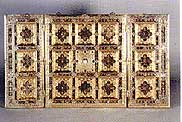 The panels known as Tablas Alfonsíes
The panels known as Tablas Alfonsíes
|
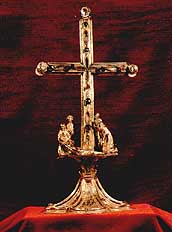 Reliquary of the Lignum Crucis
Reliquary of the Lignum Crucis
|
The silver and gold items on display in this Sacristy are very important. The main piece is the procesional monstrance made of silver by Juan de Arfe between 1580 an 1587.
Its huge structure -it has four sections of decreasing size- includes numerous sculptures and reliefs of Eucharistic symbolism.
Another eye-catching feature because of its enormous proportions is the huge triangular candelabrum made of bronze and wood for 15 candles.
It was designed by the architect Hernán Ruiz II and the sculptures at the top are by Juan Giralte and Juan Bautista el Viejo. Bartolomé Morel was in charge of the casting which took place between 1550 and 1564.
Also of great quality are the four enormous candlesticks called blandones, which are used on the Holy Week altar and were made by the silversmith Armando de Ballesteros in 1581.
|
The treasure: the cupboards which contain the magnificent Cathedrl treasure occupy the two side walls of the Sacrusty. They were made by using the remains of the chests of drawers that used to stand there and that were made by Diego Guillén Ferrant in 1551 and Diego de Velasco in 1584.
These cupboards hold a large collection of objects made of precious metqal and displayed in various showcases. Only the most exceptional items will be described in the following.
Showcases 1 and 2 have a large collection of reliquaries from different periods. Among them is the Head of St John the Baptist, made pf Polychrome wood by Juan de Mesa around 1625. The tray on which it lies is 17C silver and has enamels from Limoges.
|
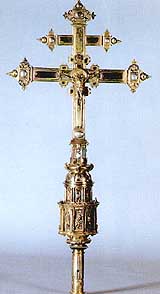 Patriarchal Cross by Merino
Patriarchal Cross by Merino
|
The most outstanding items in showcase 3 are the Tablas Alfonsíes which are made of wood plated with gilded silver.
The sunken panels on its front side contain relics covered with rock crystal. The centre and wings have magnificent cameos. The back side shows heraldic medallions of Castile and Leon as well as reliefs of The Annunciation and The Epiphany.
These panels are traditionally ascribed to Juan de Toledo, a 13C artist, and were donated to the Cathedral by Alfonso X in 1284.
|
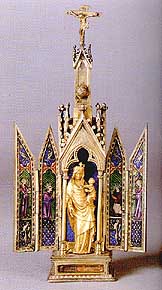 The pax of Philippe V of France
The pax of Philippe V of France |
In an adjacent unnumbered showcase there is a magnificent silver monstrance from the end of the 16C ascribed to Francisco de Alfaro.
Showcase 4 contains a splendid collection of 16C reliquaries together with the Reliquary Cross of the Lignum Crucis made of gold encrusted with enamel cabochons, cameos and precious stones.
At the foot of the cross there is a Pietà with Joseph of Arimathaea and the Holy Women. This Gothic work of art was donated to the Cathedral by Cardinal Don Pedro Gomez de Albornoz in 1389.
This showcase also includes the reliquary of Clement which has the form of a chalice probably dating from the beginning of the 16C.
Further reliquaries are preserved in showcases 5 and 6, the latter containing the Lignum Crucis of Constantino from the beginning of the 16C and reformed by Hernando de Ballesteros in 1562.
Showcase 7 shows the crown of the Virgin of Los Reyes and Child, dating from 1904. Showcase 8 has a series of Baroque and neo-Classical chalices and goblets as well as a magnificent gold and silver processional monstrance encrusted with emeralds, diamonds and pearls.
It dates from the 18C and was donated to the Cathedral by Cardinal Solís. In the nest -unnumbered- showcase there is the 16C Patriarchal Cross made of silver and donated to the Cathedral Cardinal Palafox.
|
Showcase 9 has a series of jars, amphorae, trays, paxes, incensories, censers and crosses. Especially outstanding among them is the Fuente de Paiva, a magnificent gilded silver tray of the Flemish school, which dates from the first half of the 17C. In the next -unnumbered- showcase there is a Patriarchal Cross by the silversmith Francisco Merino dating from 1557.
Showcase 10 contains a long series of chalices, goblets, paxes, altar criets and jars of great artistic value, especially the gold and enamel pax which has a Virgin with Child in its centre, while the wings show the figures of Philippe V of France and Doña Juana de Borgoña.
This exceptional piece was made in Paris around 1320. Number 11 has an 18C goblet and the urn for the Maundy Thursday altar, made in Rome by Luis Valadier in 1781. The platform was made by Francisco Leclare in 1774.
|
|
|












